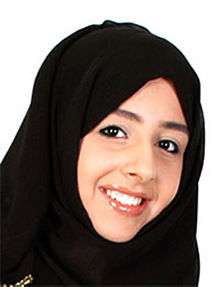Clothing in the United Arab Emirates
Clothing in the United Arab Emirates is characteristic of Arabic countries. It is an aspect of the Bedouin life in the Arabian peninsula. It is designed for comfort in high temperatures to keep with the religious beliefs in the country. Emiratis wear veils and long sleeved robes, worn especially in the summer. Clothing that cover more parts of the body from the sunlight can be preferred. However, the black female dress, abaya, captures heat due to light-absorbing color.
The Emirati national dress consists of garments and accessories such as the kandura or dishdosh (white or colored cloak) with kerkusha (string neck ornament) often worn with sandals and guthra (headscarf) with egal (black rope) for men, and abaya (black gown), shayla (head covering) and possibly burqa (head covering exposing only the eyes) or gishwa (black veil) and gafaaz (gloves) for women.[1]
Clothing and fashion trends are very important in the Middle East, because the population is very young (over 50% are under the age of 20, the median age is 28 in UAE, compared to 36 in the United States).[2]
Women's clothing

The abaya is prevalent, while some women also wear a niqab or cover their face with a hijab. Women also wear batoolas. The abaya is conventionally entirely black, but recent trends display colorful decorations around the collar or on the sleeves. The younger Emiratis wear fitted dresses when these were in the first place designed to prevent from revealing any physical shape.
Women are usually dressed in black which is evidently not the best choice of color considering the high temperatures encountered in the summer. This can also explain the prevalence of air conditioning in public areas.
Men's clothing
Men wear the dishdash, also referred to as dish-dasha or gandoora, gandurah, tawb, thwab[3] or taub (long white robe) and the headscarf (keffiyeh).
The UAE traditional Keffiyeh is white and is held in place by the agal (for which the plural is aghals) which resembles a sort of black heavy duty hosepipe.

The keffiyehs worn in the neighboring countries are not necessarily white and each Bedouin tribe will have its own colors.
The younger Emiratis prefer to wear red and white keffiyehs and tie it round their head to avoid having to wear the agal. To wear the keffiyeh the Emirati style, all one has to do is fold the headscarf once to make a triangle placing the longer side of the triangle along the forehead leaving the 90˚ corner somewhere towards the top of your back.
Then all you have to do is place the aghals on top leaving the black chords dangling in your back. If you want to wear your keffiyeh without using the aghals, simply make a triangle as described above and use the two small-angled corners to wrap them round your head, starting with the back of the head, and around the forehead to fold it back into the beginning of the loop just behind the ears. Do not use the aghals when wearing the keffiyehs in this style.
Traditional clothing
The United Arab Emirates warned its citizens to avoid wearing traditional clothing when traveling outside of the country, after a businessman was mistakenly arrested in Ohio after a hotel clerk thought he was a terrorist.[4]
Two female Emirati nationals have launched a Twitter campaign to urge expatriates and tourists to respect the cultural sensibilities of the United Arab Emirates regarding dress. Their campaign pushed the Federal National Council to propose a law regarding dress code. Some Emirati activists want to protect the local culture from being "ravaged" by Western habits in the country's cosmopolitan society.[5] While the Emiratis have preserved their local dress, they want to ensure a minimum level of decency in public places.
Many awareness signs were put in malls to urge shoppers to follow certain dressing guidelines but with no effective results. The online dress code campaign has attracted the support of many netizens.[5]
The UAE has also used Twitter and Facebook campaigns to create awareness on various issues. A recent campaign which was launched in May 2012 and has gained prominence and controversy is the "UAE Dress Code" campaign. It was started by two Emirati women, Hanan Al Rayes and Asma Al Muhairi, to create awareness and educate tourists and expatriates on dressing appropriately, respecting the country's culture and sensibilities.[6]
Sandals are the common footwear for both Emirati women and men.
See also
References
- ↑ Özlem Sandıkcı; Gillian Rice (1 January 2011). Handbook of Islamic Marketing. Edward Elgar Publishing. pp. 422–. ISBN 978-0-85793-602-8.
- ↑ Ian Yeoman; Victoria Management School Ian Yeoman (4 June 2009). Tomorrow's Tourist: Scenarios & Trends. Routledge. pp. 145–. ISBN 978-1-136-35489-2.
- ↑ "Negative effects of the media on the U.A.E culture Essay - Paper Topics". Retrieved 2016-10-19.
- ↑ "UAE Warns Citizens To Avoid Wearing Traditional Clothing While Abroad - News - Anygator.com". Retrieved 2016-08-26.
- 1 2 "UAE: Dress Code Campaign Urges Extra Inches of Clothing · Global Voices". Retrieved 2016-08-26.
- ↑ Khalid A. Al-Sayed (21 September 2013). GCC and Arab Spring. The Peninsula Publishing. pp. 19–. GGKEY:2D1WJHWK02L.
Bibliography
- Benesh, G. C. (2008). CultureShock! United Arab Emirates: A survival guide to customs and etiquette. Singapore: Marshall Cavendish International (Asia) Ptd Ltd.